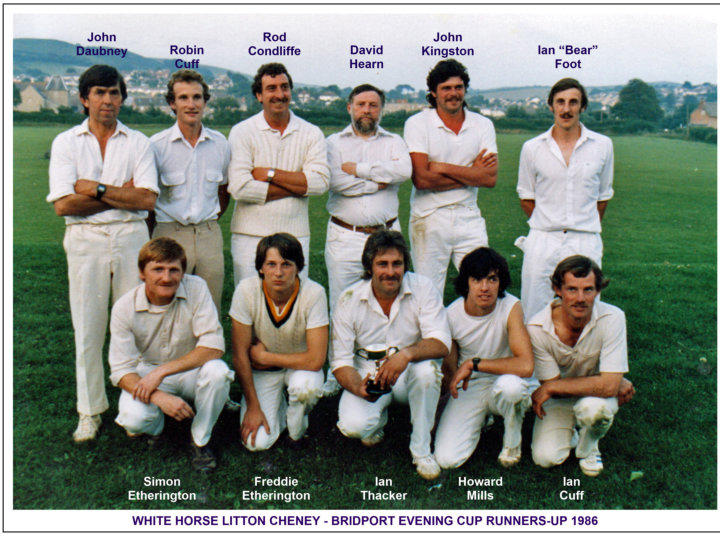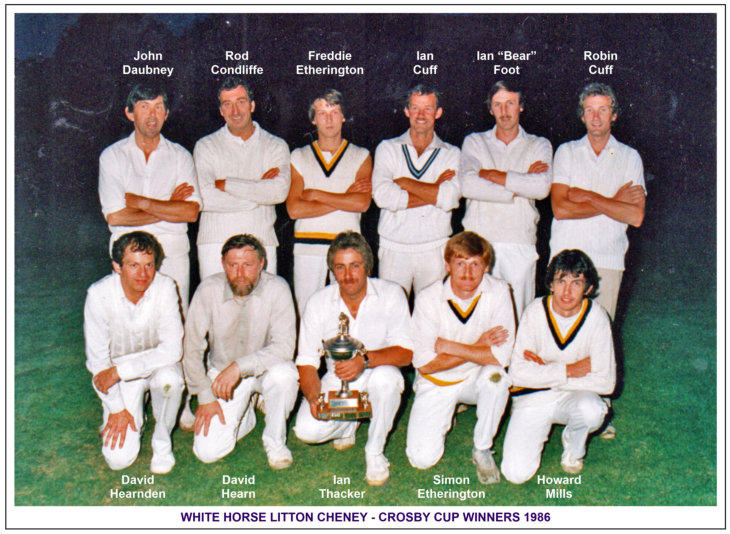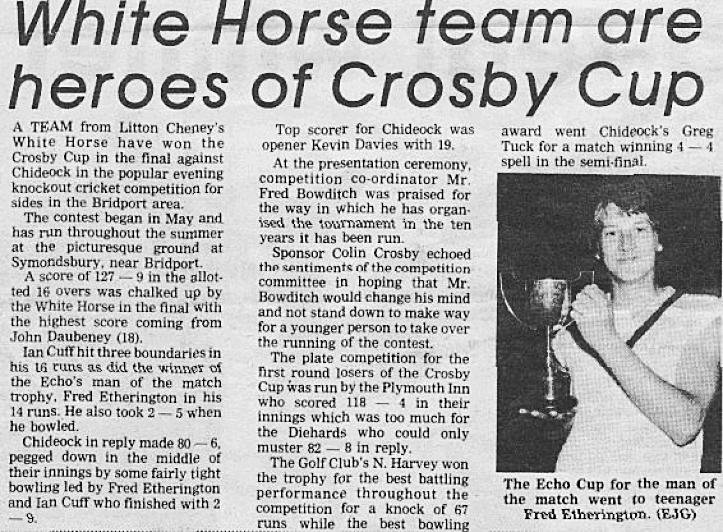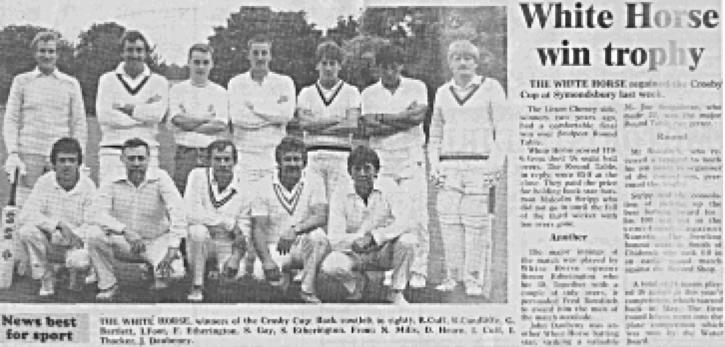History
WHITE HORSE LITTON CHENEY PUBLICANS
Data from Palmers
March 1927 - August 1929
William Edwards
August 1929 - July 1951
Philip Coates Shave
July 1951 - July 1953
John S
July 1953 - November 1959
A. H. Tomlinson
November 1959 - June 1964
A. Chapman
June 1964 - March 1976
George and Jean Fitt
March 1976 - October 1982
David and Sheila Ward
October 1982 - October 1984
David and Jean Saddington
October 1984 - September 1990
Keith and Susie Smart
September 1990 - September 1995
Les and Ada Fry
December 1995 - June 2000
D O’Brien (see note 1 below)
June 2000 - September 2003
John Blaker and Debbie Barrington
September 2003 - October 2004
Chris Eveleigh and Rachel Rogers
December 2004 - November 2005
Tony Pitcher and Susan Burt
November 2005 - September 2013
Cassie Williamson
September 2013 - May 2015
Kelvan Finch and Valerie Woods
May 2015 - June 2019
Peter and Jaemie Gull
June 2019 - present
Andy and Liz Venning
Data from Censuses etc. (see note 2 below)
1826 newspaper report
John Wittle
1841 – 1861 censuses
William Hawkins
1871 census
Samuel Wood
1881 census
George Chapple
1891 – 1911 censuses
Henry Watts Greening
Notes:
1.
During the time D O’Brien held the license he never directly acted as the landlord but appointed several ‘managers’ to
act on his behalf. Some of the managers names recalled are:
Mike and Julie Webb; Jeff and Jackie ?; Jules and ?
2.
Because a census is only held every 10 years, it is not possible to be more precise as to actual dates.
1753-54 - The Infamous Trial of Elizabeth Canning
In 1753 to 1754 there was a trial at the Old Bailey which excited public interest for many months. A young spinster of high
repute, called Elizabeth Canning, went missing for a month and arrived at her mother's house in Aldermanbury, London in
a dishevelled state. She said that she had been abducted and imprisoned in a house at Enfield Wash, had her stays
stolen, and had been 'invited' to be a prostitute which she refused. For a month she was locked in the hayloft and lived on
a loaf of bread which had been divided into twenty four pieces, a basin of water and a mince pie which she had in her
pocket. She eventually escaped through a window. A gypsy women called Mary Squires, her son George and the house-
keeper called Susannah Wells were all accused. A whore, called Virtue Hall, confirmed the story but later retracted her
evidence.
Mary said that at the time in question she was travelling in Dorset with her son and daughter Lucy, and presented three
witnesses from Abbotsbury who testified to her story. This was rejected by the court and she was sentenced to hang. The
three witnesses were then prosecuted for perjury but this accusation was thrown out of court through lack of evidence,
which therefore made the verdict on Mary deemed to be unsafe and the Chief Magistrate appealed to King George II who
agreed to a delay in sentencing and eventually a pardon. However Susannah Well's sentence of branding to the thumb
and six months imprisonment was upheld.
Public opinion was split - you were either a Canningite or an Egyptian (after gypsy) and the Chief Magistrate and Lord
Mayor of London, Sir Crisp Gascoyne was physically attacked in his coach and received death threats.
Attention then turned to Elizabeth Canning and on the 29th April 1754 she was accused of perjury. Many witnesses were
called to substantiate Mary's story including James Hawkins (most likely junior), Francis Gladman and John Fry all from
Litton Cheney. The turnpikes in Dorset were only set up in the 1760s so it must have been a long and arduous journey to
London. One which would have accorded much excitement in Litton and would have been the major talking point in the
village.
After being sworn in, James Hawkins introduced himself with the words 'I keep an ale-house at Litton'. He confirmed that
he recognised the gypsies who stayed at the inn and that they had bought fowls from 'one Dancer Turner, in our parish.'
'Were they boiled or roasted? - they were boiled, I believe; we don't eat roast meat in the country but very little.' He was
then asked if he remembered the customers and he recalled that the bell-ringers had come to the inn to refill their cider jug
as they had finished what had been given to them by the parish - 'they had been a-ringing; and the minister's kinsmen
went a fox hunting that day, and gave the people some money'. How do you know it was the 31st December?. ' By reason
I had made a fire in the little chamber on the Monday morning, when the people were ringing, where no fire had been
made before.' He had recently had some building work done and John Fry, tiler and plasterer, had been working 'in the
new Christmastime' and 'the little new chamber' was not in the house. A gardener from Litton, Francis Gladman, also
called it the new Christmastime and this was because in that very year the change had been made from the Julian to the
Gregorian calendar. (In order to make the change the 2nd September 1752 was followed by the 14th September 1752).
Gladman also said that 'the house of James Hawkins; there is no sign, it used to be the Three Horse-Shoes'. (Perhaps it
was at this time that it became the New Inn?).
Elizabeth Canning was found guilty, although two of the jurors felt it was not with intent, in other words she had been
coersed. She was sentenced to transportation to America but her supporters had raise enough for her to have a
comfortable passage. She settled in Connecticut and eventually married and had five children. She died in 1773, aged 38,
without ever explaining what really happened during the missing month.
This information and the original proceedings can be found at www.archive.org. (Second Page, item 44) Then go to
Cobbett's Complete Collection of State Trials and Proceedings for High Treason and Other Crimes and Misdemeanours
from the Earliest Period to the resent time (1809). Vol 19, pages 262-275 and 283-694. James Hawkins's testimony can be
found on page 346.
20th April 1826 – John Wittle, landlord, summoned for suffering drunkenness or tippling and disorderly conduct in his
house at Litton Cheney. Sentenced to 1 months imprisonment unless £5 penalty plus 17 shillings and 6 pence costs be
sooner paid.
17th July 1862 – Samuel Wood, landlord of the White Horse beerhouse, summonsed for a breach of the Beer Act. P C Hill
deposed that, on the morning of Sunday the 29
th
of June, he found a man in the house with a pint of ale. There had been
previous complaints about the house and he had to send an officer in private clothes. Defendant fined 40 shillings plus
costs.
3
rd
September 1863 – Mr Symonds made an application on behalf of Mr Samuel Woods landlord of the White Horse, Litton
Cheney. There having been a complaint against the applicant, the Bench would not grant him a license.
30
th
June 1922 – the problem of the porker: - an echo of the recent fete was heard when the Secretary of the Local Club
learned from ex. PC Larcombe, of Winterbourne, that he expressed himself dissatisfied with the award of the prime
Tamworth porker to Mr Ackerman, landlord of the Hope and Anchor, Bridport. Our correspondent gathers that Mr
Larcombe considers himself justly entitled to the said pig, in virtue of the fact that, on the occaision of the skittling match,
he did, by fair and sporting means, contrive to clear the board with his first ball. Moreover, he nearly repeated the
wonderful feat with the second throw when only one pin was left standing. His lucky opponent, Mr E Ackerman, did not do
this, but played the game according to the accepted rules of skittling and, after clearing the board with one shie, only
popped up the centre pin for his second ball, so that Mr Larcombe demands the pig as his due. It has been suggested,
our correspondent hears, that some means could be arranged to bring the disputing partners together and, if these two
doughty skittlers could be matched locally, their respective skill could be witnessed and decided upon under the able
referee-ship of Mr H W Greening at his Litton hostelry.
18
th
February 1925 – Superintendant Lawrence, in his annual report for the Dorchester Police Division, stated that, on the
24
th
of October 1924, the White Horse Inn, Litton Cheney, was practically destroyed by fire. Supt. Lawrence said that he
did not oppose an application which would be made for the approval of plans for the erection of new premises on the
same site.
Reported Incidents - The following historic incidents relate to the White Horse:
SPORTS NEWS
Those were the Days !!




WHITE HORSE LITTON CHENEY - CROSBY CUP WINNERS 1988

WHITE HORSE LITTON CHENEY - BRIDPORT CC EVENING CUP WINNERS 1984
1984
1986
1988
The White Horse Inn, Litton Cheney DT2 9AT
Telephone for Bookings: 01308 482539
facebook: White Horse Inn Dorset
WHITE HORSE INN



Village Information v
Local Amenities v
Village Amenities v
About Litton Cheney v
Dorset Council v
Parish Council v